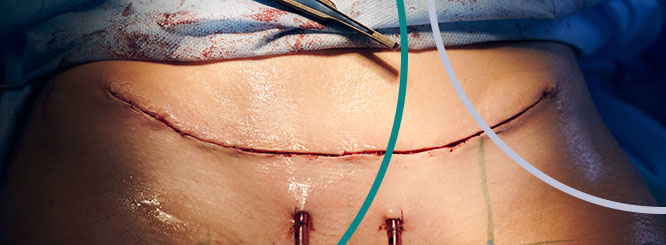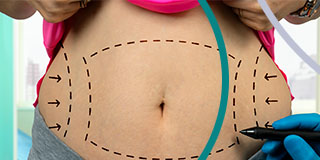
Plastic surgery is a specialty that consists in altering or restoring the human body, and it’s divided into two categories: cosmetic and reconstructive surgery. The latter focuses on improving a body part’s function, while the former aims at enhancing the body’s physical appearance. Cosmetic plastic surgery can alter almost any part of the body and one of the most popular procedures is the abdominoplasty or tummy tuck, as it’s more commonly known.
A tummy tuck can smooth the skin of the stomach and tighten any weak abdominal muscle after weight loss or pregnancy by eliminating loose, excess skin that won’t respond to diet and exercise alone. This surgery requires a horizontal incision that’s done across the abdomen, just above the pubic hairline. The size of the incision depends on the amount of skin that’s to be removed, and while scarring should be expected, the size of the scar will vary according to the patient and the type of abdominoplasty that was performed on them.
At LIMARP®, in Tijuana, MX, our team of surgeons place incisions in a way that will make the subsequent tummy tuck scar as discreet as possible. This article focuses on what to expect when it comes to tummy tuck scars and what can be done to reduce their appearance.
Types of Tummy Tuck Procedures
Abdominoplasty procedures vary depending on the extent of the surgery, meaning that the tummy tuck can also include other types of cosmetic surgeries, such a thigh lifts or liposuction. This means that the duration of the surgery and type of incision made on the body are vastly different and each patient may have a different experience depending on the tummy tuck procedure they undergo. If you’re an eligible candidate for this surgery, our team of doctors will do a full examination to determine which type is best for you and your needs.
After undergoing any type of tummy tuck, patients should expect to get a scar across the abdomen. Scarring may be more or less visible depending on the type of surgery performed and the patient’s skin healing process. Here are some examples of the types of scars each subcategory of abdominoplasty may result in:
- Traditional tummy tuck: When a traditional tummy tuck is performed, an incision is made across the abdomen, stretching from one hip to the other. Patients having a traditional tummy tuck should expect their scar to run along the same path as the incision.
- Extended tummy tuck: Those who undergo an extended tummy tuck should expect more scarring than with a traditional tummy tuck. An extended tummy tuck requires an incision that runs across the abdomen and beyond the hipbone to remove excess skin from the stomach and back flanks. This type of surgery may result in a bigger scar.
- Mini tummy tuck: A smaller scar may be expected by those who undergo a mini tummy tuck. Typically, the scar is only three to five inches in length.
Steps to Take Before Surgery
Taking certain steps before surgery can help patients gain a clear understanding of what their post-tummy tuck scar will look like, as well as help with recovery and incision healing. After deciding which surgery will be performed, your doctor will ask you to follow a list of recommendations to ensure that the tummy tuck and subsequent healing process, which includes how the scar heals, goes as smoothly as possible.
Patients should stop smoking at least six weeks before surgery. This can reduce the risk of complications during the surgery and help with the recovery process, which in turn can allow the skin to heal and scar properly. Your doctor may also recommend to follow a well-balanced diet and to exercise to improve your metabolism and overall health before going under the knife.
If you have more questions about the preoperative process and what you can do to prevent further scarring, we recommend you speak with your surgeon about the size and location of the incision for the procedure that was decided for you.
Steps to Take After Surgery
We strongly encourage our patients to follow all aftercare instructions for the best results with healing after a tummy tuck surgery, both internally and externally; this means that these instructions also include steps on how to protect your skin to make sure the scar is seen as little as possible. A tight, elastic bandage will be placed around your abdomen while you recover and it’s very important you listen to your doctor on how to care for it because if it gets infected, it’s more probable for the resulting scar to be more noticeable. They may also recommend the best positions, whether it’s sitting or laying down, for you to help ease the pain and to protect the healing skin.
Here are some steps that can help reduce the risk of complications and help with healing and scarring:
- Not smoking for a minimum of six weeks after surgery, smoking can make the scar more prominent.
- Avoid heavy lifting or strenuous activity for at least six weeks.
- Drink plenty of water.
- Eat a healthy diet of fruits, vegetables, and lean proteins.
It’s important to highlight that the recovery process may vary from patient to patient and to contact your doctor if you begin experiencing severe pain or other complications.
Caring for Scars
A scar is expected after a tummy tuck, even if you followed a proper aftercare routine. For most people, the scar will appear red or pink in color and gradually fade over several months to a year. However, not everyone scars the same way and there are several factors that contribute to how a person heals after surgery. A person’s skin type and how prone they are to getting a scar can determine how the tummy tuck incision will heal, as well as the technique your surgeon used to carry out the procedure. Other factors that can determine how noticeable the scarring can be are how well the patient followed their doctor’s aftercare instructions and if they had complications during their recovery, such as infections.
Once a tummy tuck incision heals, vitamin E oil may be applied to the scar to help keep the new tissue moisturized and if it’s used regularly, it may help diminish the appearance of the scar. Our team of doctors may also recommend other techniques or products that may help with clearing the scarring left by the incision. We also recommend protecting the scar against direct sunlight as much as possible and that the patient applies sunscreen on a regular basis to prevent the scar from darkening.
If you’re not satisfied with the topical treatments for scarring, there are other procedures, such as laser procedures, that may help with reducing the visibility of the scar. However, keep in mind that while these procedures can improve the color and texture of the scar, they do not remove it completely. Schedule an appointment with your doctor to find out if these types of procedures are appropriate for you.
Contact Us to Learn More
If you want more information about the tummy tuck or wonder if you’re an eligible candidate, schedule an appointment with one of our doctors. We can help determine the right treatment for you. Contact us online anytime or give us a call at (619) 373-0229.


